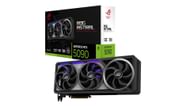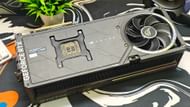The Nvidia RTX 5090 is the highest-end $2,000 flagship from Team Green this generation. Designed with the latest Blackwell architecture, this card brings better hardware packaging, improved AI features with DLSS 4, and a beefier specs sheet to improve gaming performance to unheard of levels. With 32 GB of VRAM, Nvidia has also positioned the card as a mini workstation, as it bundles enough power to handle AI workloads besides gaming and creative apps.
We got to spend a few weeks with the ROG Astral OC variant of the GPU, which is arguably one of the highest-end 5090s you can buy. Read on to find out how it fares in our tests.
The ROG Astral RTX 5090 OC is as high-end as gaming GPUs get
 The ROG Astral OC is one of the highest-end 5090 variants (Image via Amazon)
The ROG Astral OC is one of the highest-end 5090 variants (Image via Amazon)The ROG Astral OC is the highest-end design from Asus. It's only offered for the 5090 and 5080 GPUs, given that its high-end cooling solution would be overkill for the 5070 and below. The GPU features a near four-slot design with 360mm depth, making it one of the largest cards I've ever tested. The operating speeds have been boosted to 2,580 MHz, up from the 2,407 MHz speeds of the base FE card.
Under the hood, you get a slightly overclocked RTX 5090 32 GB GPU. Based on the new Blackwell architecture with 21,760 CUDA cores, this card is designed for enthusiasts with deep pockets. You get the flagship GB202 chip, directly derived from the B200, powering server-grade hardware. Moreover, the card is filled to its brim with 28 Gbps of GDDR7 memory that pushes 1.79 TB/s (compared to the 1 TB/s 4090).
 The ROG Astral OC card weighs a whopping 3.06 kg (Image via Sportskeeda)
The ROG Astral OC card weighs a whopping 3.06 kg (Image via Sportskeeda)Here's a detailed look at the specs sheet of the GPU:
| GPU / Chipset | NVIDIA GeForce RTX 5090 (Blackwell architecture) |
| CUDA / Core Count | 21,760 CUDA cores |
| AI Performance | 3,593 TOPS (AI) |
| Memory | 32 GB GDDR7 |
| Memory Speed | 28 Gbps (effective) |
| Memory Interface / Bus Width | 512-bit |
| Base / Boost / Overclock Clock Speeds | Default (Boost) mode: ~2,580 MHz ; OC mode: ~2,610 MHz |
| Bus Standard / Interface | PCIe 5.0 |
| OpenGL Support | OpenGL 4.6 |
| Cooling / Thermal Design | Quad-fan “Quad-Fan Force” design with enhanced airflow & pressure (up to ~20 % increase), Patented vapor chamber with milled pathways, Phase-change GPU thermal pad for improved contact, 3.8-slot heatsink/fin array design, Full metal die-cast shroud, frame, backplate, and rigid I/O bracket |
| Power Delivery / VRM | 80-amp MOSFETs, premium power delivery design, ~35 % more headroom over baseline, Protective conformal coating on PCB (moisture/dust defense) |
| Additional Features | GPU Tweak III software support (tuning, thermal controls, monitoring), Auto-Extreme manufacturing process, GPU Guard (adhesive reinforcement at corners), and a GPU bracket for stability, Indirect ARGB / Aura lighting integration |
| Dimensions | 357.6 x 149.3 x 76 mm, 14.1 x 5.9 x 3 inch, Slots: 3.8-slot thickness, Cooling fans: 4 × Axial-tech fans (quad) |
| Pricing / Model Info | Listed price (Asus e-store): ~ US$ 3,359.99, MPN / Model: ROG-ASTRAL-RTX5090-O32G-GAMING |
The card is priced at a whopping $3,359—that's $1,359 more than the MSRP. Given the high-end cooling treatment, RGB, and increasing operating speeds shipped with the card, one can justify the price. That doesn't mean it won't drill a solid hole in your pocket.
Read more: Is the Nvidia RTX 5070 worth buying for gaming?
How does the ROG Astral RTX 5090 OC perform?
 The ROG Astral 5090 features a fourth fan (Image via Sportskeeda)
The ROG Astral 5090 features a fourth fan (Image via Sportskeeda)For testing, we employed a 9950X3D-based setup to ensure the GPU isn't limited by the system chip. This makes for the fastest gaming PC you can buy today.
- CPU: AMD Ryzen 9 9950X3D
- Motherboard: Asus ROG Crosshair X870E Apex
- RAM: 2x G.Skill Trident Z DDR5-6000 16 GB
- Storage: 1x Gigabyte Gen 4 NVMe 1 TB, 1x Patriot P300 M.2 PCIe Gen 3 x4 128GB
- Cooler: Cooler Master Atmos 240mm liquid cooler
- Storage: Asus ROG Thor Platinum III 1200W
- GPU: Zotac RTX 5070 12 GB Solid OC
Synthetic benchmarks
We will first look at a few synthetic benchmarks to get an idea of where the 5090 stands in comparison to the competition before shifting to AI and gaming tests.
Let's start with 3DMark Fire Strike, where the 5090 easily takes the top spot in our leaderboard by scoring 63,593 points. Compared to the 4090, the card is 22% faster, which can be attributed to a mix of beefed-up specs sheets and architectural improvements.
Next, we test 3DMark DXR, which is a test of ray tracing. Since this has been Nvidia's strong suit, we see only Nvidia RTX GPUs cluster towards the top, with the 5090 beating the next-best, the RTX 5080, by a staggering 36%.
3DMark Steel Nomad tests a more contemporary tech stack: DirectX 12 Ultimate with real-time ray tracing, mesh shaders, and high-resolution 8K textures. The 5090's added hardware and VRAM helps it tremendously, as it scores a 67% lead over the next-best, the 5080, and 101% over AMD's best, the 9070 XT.
In 3DMark Port Royal, we see a similar trend continue. The RTX 5090 manages a 67% performance jump over the 4090 and 5080.
In another DirectX 12 Ultimate RT benchmark, Speed Way, the RTX 5090 is again 60% faster than the 5080 and a healthy 123% faster than the AMD Radeon RX 9070 XT. While price-to-performance scales linearly, Team Red has yet to introduce a flagship that can match the 5090. The $999 7900 XTX continues to lag, with the 5090 being 141% better.
In the DLSS test, 50-series cards get the added benefit of DLSS 4 Multi-Frame Generation (MFG). With the added rendering capabilities, the card also gets a higher base framerate to multiply from, giving us 86.34 FPS at native resolution and 257.39 FPS with DLSS, a 2.98× gain. This hints that ~20 FPS was lost to loading and running the Transformer-based upscaling and MFG models.
Gaming benchmarks
We tested the RTX 5090 in some of the latest video games, including Battlefield 6, Black Myth: Wukong, Monster Hunter Wilds, alongside a few competitive (Counter-Strike 2) and classic (Far Cry: New Dawn) titles. Here's how the GPU performed:
Game | Setting | 0.1% (FPS) | 1% (FPS) | Avg (FPS) |
Battlefield 6 | Overkill + DLAA | 55 | 76 | 108 |
Overkill + DLSS Quality | 30 | 110 | 151 | |
Overkill + DLSS Performance | 73 | 112 | 179 | |
Overkill + DLSS Performance + FG 2× | 82 | 96 | 262 | |
Overkill + DLSS Performance + FG 3× | 25 | 105 | 257 | |
Overkill + DLSS Performance + FG 4× | 81 | 100 | 360 | |
Overkill + DLAA + FG 3× | 70 | 77 | 266 | |
Star Wars Jedi Survivor | Epic | 17 | 51 | 101 |
Epic + RT | 57 | 68 | 96 | |
Epic + RT + DLSS Performance | 54 | 91 | 160 | |
Epic + RT + DLSS Performance + FG | 103 | 163 | 231 | |
Black Myth Wukong | 4K no RT, no DLSS | 47 | 50 | 59 |
4K RT no DLSS | 25 | 26 | 30 | |
4K RT DLSS Perf | 69 | 84 | 112 | |
4K RT DLSS Perf + FG | 83 | 140 | 172 | |
Far Cry: New Dawn | 4K 1× resolution scaling | 78 | 101 | 195 |
4K 2× resolution scaling | 37 | 62 | 79 | |
Cyberpunk 2077 | Path Tracing + FG 4× + DLSS Perf | 137 | 191 | 264 |
Path Tracing + FG 3× + DLSS Perf | 111 | 149 | 214 | |
Path Tracing + FG 2× + DLSS Perf | 80 | 114 | 155 | |
Path Tracing + DLSS Perf | 53 | 65 | 91 | |
Path Tracing only | 25 | 27 | 32 | |
RT Ultra | 41 | 45 | 58 | |
no RT | 60 | 71 | 111 | |
Counter-Strike 2 | no FSR | 129 | 155 | 302 |
FSR Performance | 195 | 233 | 402 | |
Average (All Tests) | 69.8 | 98.5 | 171.0 |
Overall, 4K performance is exceptionally strong on the 5090, regardless of how high the settings are cranked. You can easily expect triple-digit framerates in almost every title. DLSS multi-frame generation, although a nice-to-have, isn't much needed. Here's a breakdown of how average FPS fares across different settings:
| Native (no RT, no DLSS/FSR) | Baseline rasterized native rendering | 65.7 | 85.7 | 142.3 |
| Ray Tracing / Path Tracing | Includes RT, PT, and RT Ultra modes | 63.1 | 87.2 | 97.1 |
| DLSS / FSR (no Frame Gen) | Upscaling without frame generation | 68.5 | 100.6 | 166.0 |
| Frame Generation (any type) | DLSS/FG/FSR FG modes | 90.9 | 132.4 | 257.3 |
The 5090 is a beast of a gaming GPU, to the point where there's no competition. 4K 140+ FPS at native resolution is strong, and 97 FPS with ray tracing turned on hints at the collective power of the rendering hardware. However, the $3,359 price tag could be a prohibitive barrier to this premium performance.
AI tests
We tested the RTX 5090 in LLM inference. Given its large 32 GB VRAM buffer, models with up to 30B parameters easily load into memory. We report performance across token/s speeds and time to first token speeds, alongside RTX 5070's numbers reported for comparison.
| Model name | Inference speed (RTX 5090) | Time to first token (RTX 5090) | Inference speed (RTX 5070) |
| SmolVLM 256M (F16) | 593.64 tok/s | 0.03s | 477.70 tok/s |
| InternVL3 8B (Q8_XL) | 130.87 tok/s | 0.5s | 17.26 tok/s |
| InternVL 3.5 30B A3B (Q6_K) | 171.89 tok/s | 0.3s | 17.38 tok/s |
| Qwen 2.5 VL 32B (Q6_K) | 24.77 tok/s | 0.51s | 17.18 tok/s |
| Kimi VL A3B Thinking 16B (Q8_0) | 17.27 tok/s | 0.6s | 17.08 tok/s |
Models that achieve ~25 tok/s speeds or less didn't fit into the GPU's VRAM and were offloaded to the system RAM. This bottleneck inference speeds by relying on the much slower Ryzen 9 9950X3D's inference capabilities.
The RTX 5090 easily handles models like Gemma3 27B, or InternVL 3.5 30B. However, anything more than that, like Qwen 2.5 VL 32B, tanks tok/s speeds significantly. Despite the added capabilities, this makes the 5090 only good for hobbyist tinkering and prototyping.
Read more: Nvidia RTX 5080 review
Stress tests
The ROG Astral OC GPU bundles over 3 kilograms of heatsink to tame the GB202 graphics chip in the RTX 5090. We expected it to perform well in our thermal test. We stress-tested the card with Furmark 2's GPU torture utility. The characteristic graph is below. These tests were conducted with a controlled ambient temperature of 21°C.
The RTX 5090 hit a maximum of just 50.5°C, just 30 degrees over the ambient temperature. The memory junction temperature, generally the hottest point on modern GPUs, maxed out at 72°C, staying comfortably below the safe limits.
In terms of power draw, the card consistently drew a maximum of 600W under full load. Given the advanced design of the GPU, we didn't expect any anomalies in this test.
Should you buy the ROG Astral RTX 5090 OC?
The ROG Astral RTX 5090 OC is an impressive GPU in terms of its design, performance, and capabilities. However, there are a couple of limitations: first, the $3,359 price is prohibitively expensive for many, and second, the 4-slot 360mm design warrants several large cases as invalid.
You also need to invest in a high-quality power supply to ensure decent performance that doesn't melt down your system. For our tests, we found the ROG Thor Platinum III sufficed. Make sure your PSU supports the latest ATX 3.1 standard and ships with 12 VHPWR cables out of the box. You'll need a capable CPU (at least a Ryzen 7 9800X3D) to avoid any bottlenecks.
All of this significantly drives up the total cost, making the card lucrative only for those with a $5,000+ total budget. If you have the cash, there's no better graphics chip (besides similarly high-profile options from Gigabyte and MSI).
Why did you not like this content?
- Clickbait / Misleading
- Factually Incorrect
- Hateful or Abusive
- Baseless Opinion
- Too Many Ads
- Other
Was this article helpful?
Thank You for feedback
About the author
Edited by Arka Mukherjee

.jpg) 3 hours ago
2
3 hours ago
2

 English (US)
English (US)